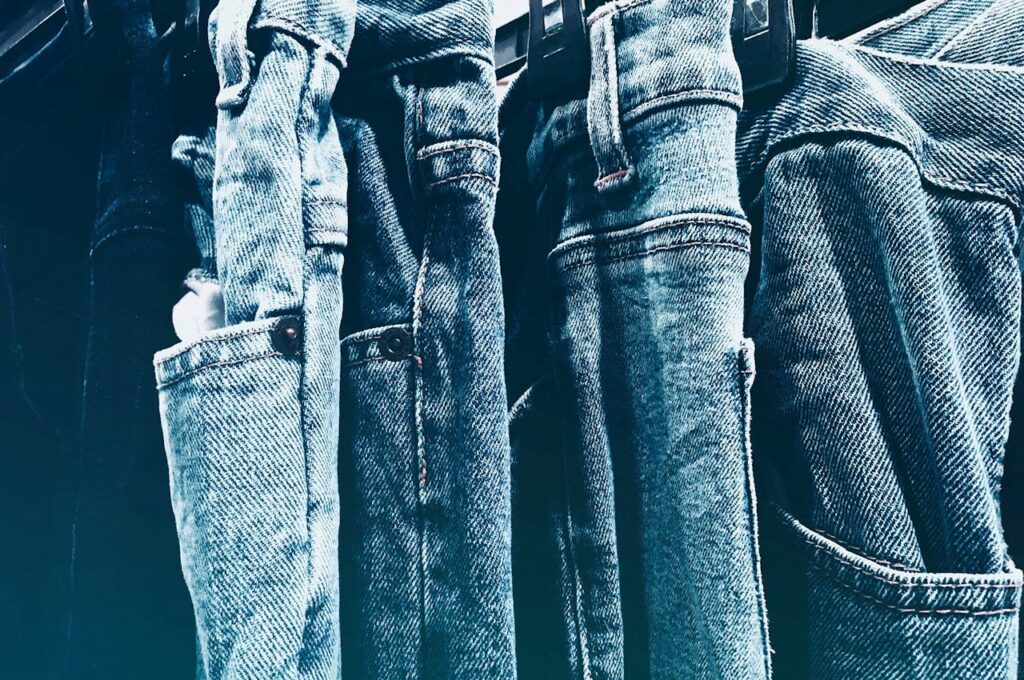Denim jeans are a timeless wardrobe staple, but have you ever wondered what goes into making them? The journey from raw fabric to the jeans in your closet is a fascinating process involving multiple steps and meticulous attention to detail. Let’s take a closer (and funnier) look at the comprehensive process of manufacturing denim jeans.
1. Concept and Design
Every great pair of jeans starts with a vision. Imagine designers sketching away like modern-day Michelangelos, except with fewer marble statues and more fabric swatches. They brainstorm, sketch, and create detailed specs, considering style, fit, and unique features. Patterns are made for each part of the jeans, such as the front and back legs, waistband, and pockets. These can be created manually or using specialized software.
- Designing the Look: Creative geniuses unite! Sketches and mood boards are like fine art, but wearable.
- Pattern Making: Precision is key, whether done by hand or with CAD software, to ensure each piece fits perfectly. It’s like a giant jigsaw puzzle, but the end result is way cooler than a picture of a landscape.
2. Fabric Selection and Cutting
Next up, selecting the right fabric. Denim comes in various weights and blends, each suited to different styles and purposes. The chosen fabric undergoes a thorough inspection to identify any defects. After inspection, the fabric is laid out in multiple layers and cut according to the patterns using automated cutting machines or electric scissors. It’s a bit like slicing a giant denim cake.
- Choosing the Fabric: Imagine a room full of denim options, like Willy Wonka’s factory but for fabric lovers.
- Inspection: Ensuring the fabric is free from defects because nobody wants a hole in their new jeans (unless it’s stylishly intentional).
- Cutting: High precision is achieved with advanced cutting technology. Picture a ninja with electric scissors.
3. Sewing and Assembly
Now it’s time to bring the pieces together. Industrial sewing machines are used to stitch the pieces into a cohesive garment. Key steps in this phase include:
- Stitching the Inseam and Outseam: Joining the legs of the jeans. Think of it as leg day for fabric.
- Attaching Pockets: Adding front and back pockets because where else would you put your phone, keys, or emergency snacks?
- Constructing the Fly: Creating the zipper or button fly, a delicate operation akin to performing denim surgery.
- Adding the Waistband: Securing the waistband and attaching belt loops. It’s like putting the crown on the king of jeans.
- Reinforcement: Stress points, like pocket corners and the base of the fly, are reinforced with bar tacks or rivets for durability. Because nobody likes wardrobe malfunctions.
4. Washing and Finishing
To achieve that perfect look and feel, most jeans go through a washing and finishing process:
- Pre-washing: This softens the fabric and gives it a worn appearance. Techniques include:
- Stone Washing: Using pumice stones for a faded look. Imagine jeans going through a spa treatment.
- Enzyme Washing: Using enzymes to soften the fabric. It’s like sending your jeans to a gentle yoga retreat.
- Acid Washing: Applying chlorine to create contrast. This one’s for the daredevil jeans.
- Dyeing and Tinting: Additional dyeing processes might be applied for specific color effects. Think of it as denim’s makeover montage.
- Distressing: Methods like sandblasting, hand sanding, and laser treatments create a distressed look. Perfect for that “I’ve had these forever” vibe.
- Drying and Ironing: Post-washing, jeans are dried and ironed to remove wrinkles and prepare for final touches. A bit like sending them to boot camp.
5. Finishing Touches
The final steps ensure each pair of jeans meets quality standards:
- Trimming Threads: Removing loose threads for a clean finish. It’s like giving your jeans a haircut.
- Attaching Labels and Tags: Adding brand labels, size tags, and care labels. Because jeans love accessories too.
- Quality Control: Inspecting each pair for stitching, fit, and overall appearance. Think of it as a jeans beauty pageant.
- Packaging: Folding and packing the jeans for shipment. Ready for their journey to a new home.
6. Distribution
The journey concludes with distribution:
- Shipping: Jeans are shipped to retailers or directly to customers, with logistics management ensuring timely delivery. Picture jeans embarking on an epic quest.
- Retail Display: In stores, jeans are displayed to highlight their features and fits. It’s their time to shine on the fashion stage.
Embracing Sustainability and Technology
In today’s world, sustainability is key. Many manufacturers are adopting eco-friendly practices such as using organic cotton, reducing water consumption, and utilizing sustainable dyes. Additionally, technological advancements like 3D body scanning for custom fits and automated sewing robots are revolutionizing the industry.
- Eco-Friendly Practices: Using sustainable materials and reducing environmental impact. Saving the planet one pair of jeans at a time.
- Technological Innovations: Implementing advanced technology for efficiency and customization. The future is now, and it’s wearing denim.


